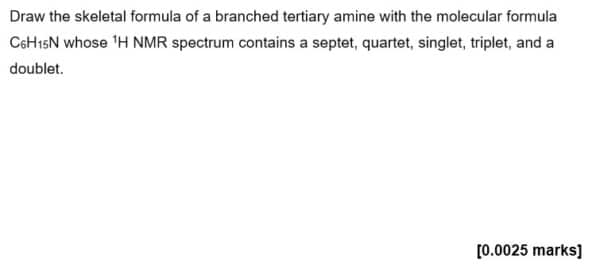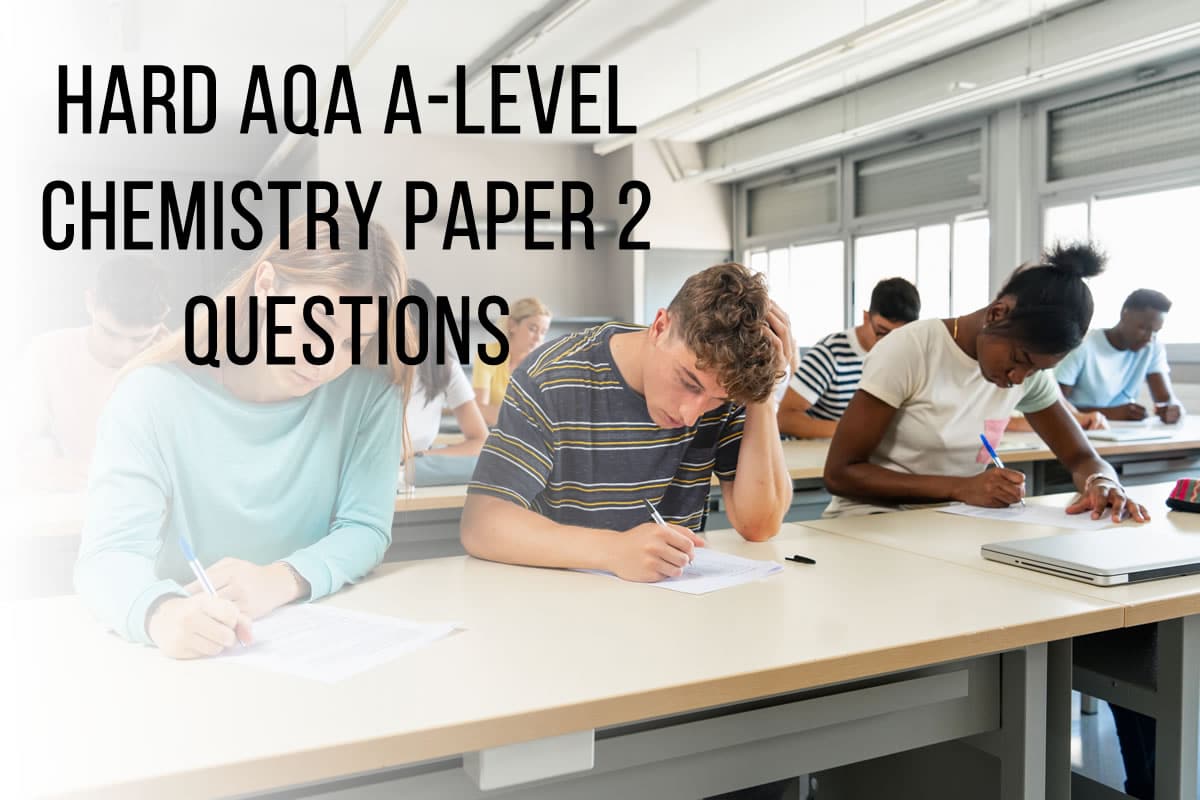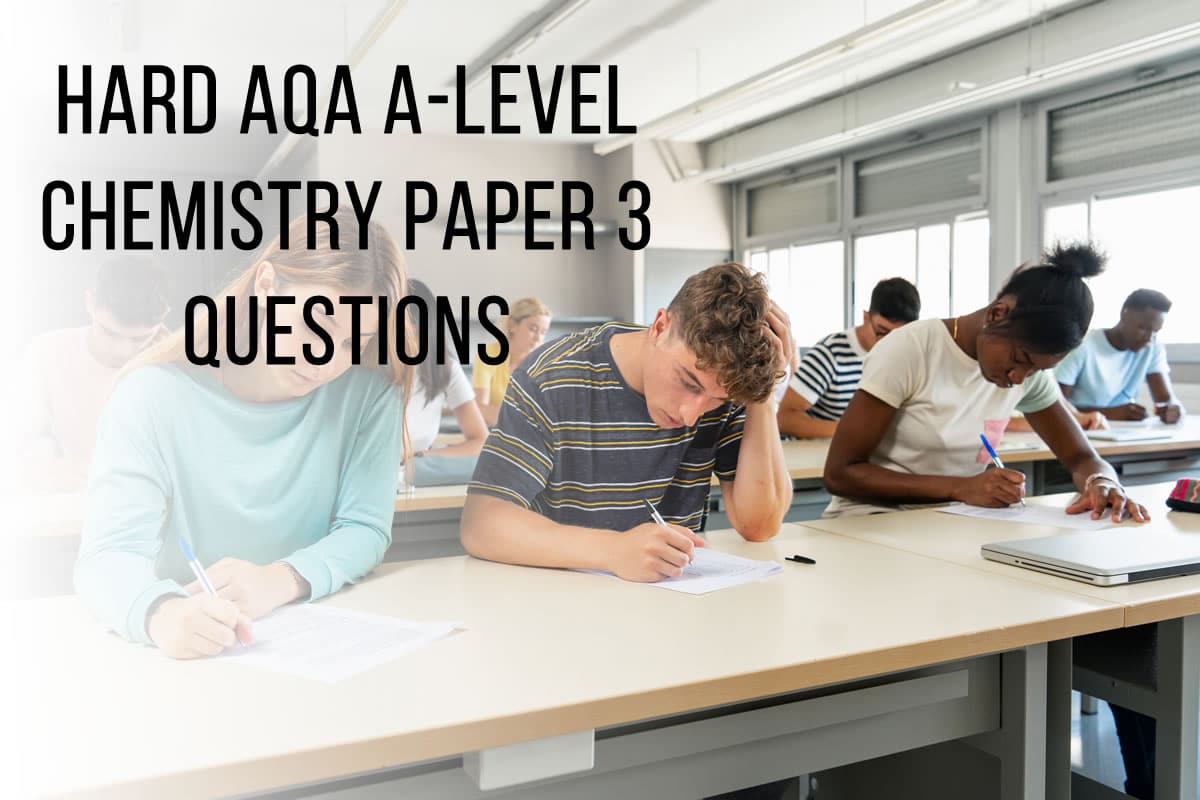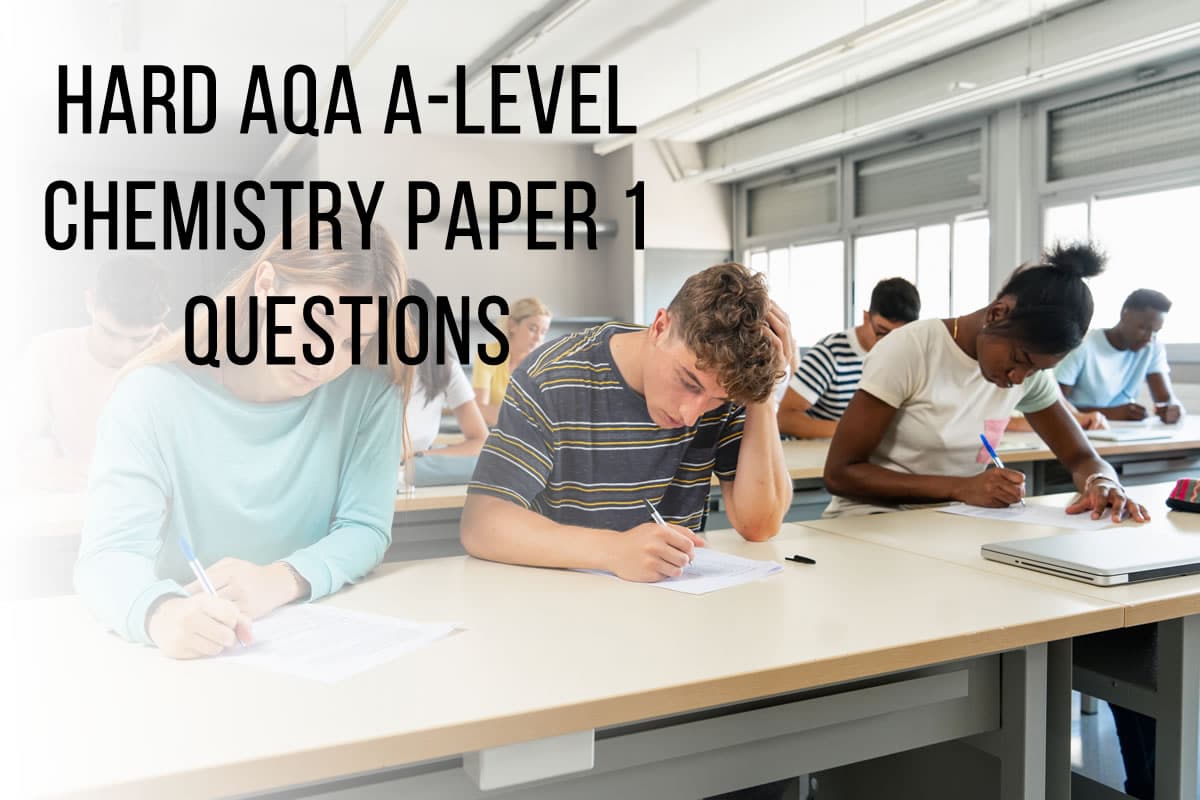Hard Organic Questions from AQA A-Level Chemistry Paper 2
Key Points:
- Organic chemistry questions make up by far the biggest proportion of difficult questions on the organic and physical paper
- The harder physical chemistry topics are on kinetics, Arrhenius in particular
- Organic mechanisms account for the highest proportion (roughly 20%) of difficult paper 2 questions
- Questions on practical chemistry (especially organic laboratory techniques) are the next highest proportion
- Organic analysis (especially NMR) and organic synthesis account for a high proportion of the most demanding questions
- As for paper 1, multistep calculations also frequently discriminate between top grades
- A large proportion of difficult paper 2 questions are based on isomers – in fact, AQA seem to have a bit of an obsession with them!
Contents
- Organic Chemistry Is the Main Challenge on Paper 2
- Paper 2 Topics That Repeatedly Cause Students Difficulty
- 2017 AQA A2 Paper 2
- 2018 AQA A2 Paper 2
- 2019 AQA A2 Paper 2
- 2020 AQA A2 Paper 2
- 2021 AQA A2 Paper 2
- 2022 AQA A2 Paper 2
- General Tips for Tackling Hard Organic Questions
- Understanding and Mastering Organic Mechanisms
- Practise, Practise, Practise: How to Get Good at Solving NMR Questions
- How Do I Prepare For A-Level Practical Chemistry Questions?
- How To Approach Difficult Kinetics Questions
- Final Remarks
Organic Chemistry Is the Main Challenge on Paper 2
Ah, organic chemistry, with its mysterious symbolic language, complicated naming system, curly arrows, reagents and conditions.
It seems to strongly divide my students. They either love it, or hate it (I’m in the former category, but I’m biased because my PhD was in organic chemistry. Still rubbish at drawing hexagons though!).
Organic chemistry is challenging because there is a lot of content involving some difficult and abstract ideas, which must first be understood before it can be applied, and then there is a lot of application.
It’s no surprise to see that most of the hard questions are on organic mechanisms. Nor is it a surprise that practical chemistry accounts for a higher proportion of hard questions on paper 2 than paper 2. Those organic practicals have a lot more apparatus and techniques to get your head around.
NMR has a reputation for being a difficult topic, so you’d expect to see it in this guide. One of the biggest challenges with NMR is solving the questions within the time limit. AQA also specialise in these odd ‘puzzle’ questions that can be fiendishly difficult to solve quickly, for example:

(OK, I may have made that question up. But the real ones aren’t much better!)
Also, make sure you know your isomers inside out. AQA love isomers. They particularly love the joyful combination of isomers and NMR.
Let’s look at the topics that examiners say are the ones that most frequently separate “top students from less able ones” (AQA’s wording, not mine).
Paper 2 Topics That Repeatedly Cause Students Difficulty
Amount of substance
- Combustion analysis, involving the ideal gas equation, to deduce the identity of organic compounds.
- Extended calculations using experimental data, particularly involving unfamiliar practicals.
Biological chemistry
- Drawing DNA bases correctly to show hydrogen bonding.
- Drawing nucleotides.
- Recognising and drawing disulfide bridges between peptide chains.
- Types of interactions between amino acids and peptide chains and their relative strengths.
- Drawing zwitterions.
Equilibrium
- Predicting the effect of changing reactant or product concentrations on the position of equilibrium and Kc.
- Calculating amounts/concentrations from Kc using algebra.
Kinetics
- Deducing initial concentrations based on comparative rate data.
- Understanding the sample and quench method.
- Using excess reactants to give pseudo-zero order conditions.
- Observations that signal consumption of reagents in kinetic studies.
- Calculations based on rearranging the Arrhenius equation.
- Plotting Arrhenius graphs.
- Calculating activation energy from the gradient of Arrhenius graphs
Organic analysis
- Using IR and NMR data alongside chemical information to deduce structures, particularly of isomers.
- Using 13C NMR to distinguish or identify isomers.
- Using 1H NMR to distinguish or identify isomers.
- Predicting the number of NMR peaks for given structures.
- Explaining the appearance of NMR multiplets in terms of the n+1 rule.
- Explaining the chemical shifts of structural units within molecules.
- Explaining the use of solvents and the TMS standard in NMR.
- Polarity of organic molecules and impact on Rf values in chromatography.
- How solvent affects Rf values in chromatography.
- Use of HRMS to distinguish compounds.
Organic chemistry (isomers, functional groups, reactions, nomenclature)
- Identifying higher amine by-products formed from multiple substitutions in nucleophilic substitution reactions.
- Identifying functional groups in polyfunctional molecules.
- Identifying by-products of reactions, particularly those involving polyfunctional reactants.
- Identifying the products of hydrolysis (esters and amides).
- Identifying and drawing isomers from chemical and analytical data.
- Identifying and drawing stereoisomers from nucleophilic addition reactions.
- Identifying the isomeric products of elimination reactions.
- Identifying reagents and intermediate compounds in organic synthesis.
- Identifying monomers for condensation polymers
- Drawing the requested structure type correctly (displayed, skeletal etc.).
- Using functional groups tests to distinguish compounds.
- Understanding the specificity of reagents towards functional groups (e.g. NaBH4 reduces carbonyls but not alkenes).
- Deducing the structure of cyclic molecules based on chemical and analytical data.
- Explaining the relative nucleophilicity and basicity of amines.
- Explaining the rationale behind organic mechanisms
- Writing novel mechanisms.
- Drawing correct mechanisms and intermediates for
- Friedel-Crafts acylation
- Electrophilic addition
- Nucleophilic addition-elimination
- Writing equations for hydrocarbon cracking.
- Writing equations to describe radical substitution reactions.
- Writing equations for formation of biodiesel from esters.
- Writing balanced equations for organic reactions involving unfamiliar reactants (especially oxidations and reductions).
- The chemistry of biofuel production and their advantages.
- Influence of the inductive effect on rates and regioselectivity.
- The addition of electrophiles to unsymmetrical alkenes and carbocation stability.
- Explaining the stability of benzene in terms of its structure (delocalisation and resonance)
Organic nomenclature
- Nomenclature of nitriles.
- Nomenclature of alkene stereoisomers (E-Z system).
- Nomenclature of molecules with multiple functional groups.
- Nomenclature of more structurally complex cyclic molecules.
Practical chemistry
- Relating intermolecular forces to boiling points and distillation
- Strategies to increase yield when distilling liquids
- Understanding the stages of recrystallisation
- Understanding the work-up stages in organic synthesis, including use of quenching reagents and drying agents
- The apparatus and techniques involved with preparing a pure organic liquid
- Understanding the immiscibility of solvents and water
- How to accurately weigh samples
- Drawing apparatus diagrams
| Question Number | Question Type | Topic | Examiner Comments |
|---|---|---|---|
| Q1.1 | Extended response | Organic chemistry (deducing structures/isomers) | Many students failed to show the O-H bond in a displayed formula. |
| Q1.4 | Extended response | Nucleophilic substitution | Only 30% of students scored both marks. Many drew a primary amine or a non-skeletal structure. |
| Q2.3 | Calculation | Kinetics (rate equations) | Over half of the students failed to score. Common errors were related to rate value or square root calculations. |
| Q3.2 | Calculation | Kinetics (Arrhenius) | 47% of students scored full marks in this new topic. Others made errors in equation rearrangement or units. |
| Q4.1 | Extended response | Organic chemistry (nomenclature) | 56% of students gave the correct answer. |
| Q4.4 | Extended response | Nucleophilic addition to carbonyls | Many students deduced incorrect products. |
| Q7.1 | 6-mark Extended response | Functional group tests | Some students lacked a systematic approach to testing. |
| Q8.6 | Extended response / Practical | Chromatography and polarity | Many students struggled to deduce the answer to an unfamiliar practical situation. |
| Q8.7 | Extended response / Practical | Chromatography and polarity | 10% of students did not attempt this and only the best students were able to explain their deduction. |
| Q9.2 | Extended response | DNA | Only 23% were able to draw thymine correctly, with the correct orientation, and linked correctly to adenine. |
| Q10.1 | Extended response | Organic chemistry (nomenclature) | Only 10% of students answered this difficult question correctly. |
| Q10.2 | Extended response / Calculation | Ideal gas equation | Many students made errors in calculations or misinterpreted the question. |
| Q10.3 | Extended response | Organic analysis (NMR + IR) | Many students struggled to relate an aspect of its structure to a peak/signal. |
| Q10.4 | Extended response | Organic analysis (NMR) | Few students gave a correct comparison of the spectra. |
| Q10.5 | Extended response | Organic analysis (NMR) | Most students missed that the two CH2 groups were identical, leading to incorrect predictions. |
| Q10.6 | Extended response | Condensation polymers | Many students found the structure of T difficult. |
| Q10.7 | Extended response | Condensation polymers | Many answers were vague and missed the required comparison. |
| Q11.1 | 6-mark Extended response | Amines | The concept of delocalisation of the nitrogen lone pair was poorly explained by many. |
| Q11.2 | Extended response | Organic synthesis | This was not answered well. Some students started with nitration, which rarely led to any marks. 8% of students did not attempt this. |
| Question Number | Question Type | Topic | Examiner Comments |
|---|---|---|---|
| Q1.2 | Extended response | Alkane cracking | Many students struggled with the pressure condition. Common errors included stating low or high pressure. |
| Q1.3 | Extended response | Radical substitution | Only the better students scored both marks. Common errors included ambiguous radicals or poor dot placement. |
| Q2.1 | Extended response | Organic chemistry (nomenclature) | Only 40% gained the mark due to errors in IUPAC rules. |
| Q2.2 | Extended response | Nucleophilic substitution | Many struggled to explain bond polarity using electronegativities. |
| Q2.3 | Extended response | Organic chemistry (deducing structures/isomers) | 39.4% answered correctly. Common errors included incorrect displayed formulas. |
| Q2.4 | Extended response | Organic chemistry (deducing structures/isomers) | Some drew incorrect bonds or missed the need for acid with KCN. |
| Q3.1 | Extended response / Practical | Intermolecular forces | 28.3% identified the types of forces correctly. Some discussed bond breaking instead. |
| Q3.2 | Extended response / Practical | Distillation | Only 4% scored both marks. 39.2% scored at least one mark. |
| Q3.4 | Calculation | Enthalpy changes / calorimetry | This question discriminated well. Some students forget the negative sign to show the reaction is exothermic. |
| Q3.5 | Extended response | Elimination reactions | Common errors included confusing this mechanism with the elimination of HX from a halogenoalkane. |
| Q3.6 | Extended response | Organic chemistry (deducing structures/isomers) | Challenging for many. Some discussed formation of different alkenes instead of E-Z isomerism. |
| Q4.4 | Extended response | Equilibrium | 65.8% of students failed to score. Many were unfamiliar with the concept of equilibrium shifting. |
| Q5.1 | Calculation | Rate of Reaction - Calculations | Some students failed to give answers to three significant figures or had incorrect signs for units. |
| Q5.4 | Extended response | Kinetics (Arrhenius) | Some students chose a wrong scale for the y-axis or plotted inaccurately. |
| Q6.1 | 6-mark Extended response | Benzene (bonding) | Some students made errors like "hydration" for hydrogenation or unclear discussion about bond breaking. Only 15.3% of students achieved Level 3 answers, and only 5% overall scored 6/6. |
| Q6.2 | Extended response | Organic chemistry (delocalisation and stability) | Only 8% of students scored full marks in this challenging question. |
| Q7.1 | Extended response | Electrophilic substitution | Some drew structures with insufficient care or omitted charges on ions. |
| Q8.2 | Extended response | Amino acids | 12.6% made no attempt. Many were unfamiliar with disulphide bridges. |
| Q8.4 | Extended response | Amino acids | Over half drew a correct zwitterion. Common errors included drawing the wrong amino acid or omitting oxygen atoms. |
| Q9.3 | Extended response | DNA | Only 14.4% gained two marks. Many drew incorrect structures or omitted the CH2 group linking the sugar to phosphate. |
| Q10.2 | Extended response | Organic chemistry (deducing structures/isomers) | Some students drew cyclic secondary amines or made errors in the number of carbon atoms. |
| Q10.3 | Extended response | Amine synthesis | Many students were unaware of further substitution reactions after forming a primary amine. |
| Q10.6 | Extended response | Amine synthesis | Only 7.7% could describe the formation of the phenylammonium ion. |
| Q11.2 | Extended response | Condensation polymers | 55.3% answered correctly. Some drew cyclic or aromatic structures with incorrect carbon counts. |
| Q11.3 | Extended response | Organic analysis (NMR) | 32% answered correctly. Some drew structures with too few hydrogen atoms. |
| Q11.4 | Extended response | Organic analysis (NMR) | 40% answered correctly. 20.7% did not attempt the question. |
| Question Number | Question Type | Topic | Examiner Comments |
|---|---|---|---|
| Q1.1 | Extended response | Amine synthesis | Many students struggled with balancing the equation. Common errors included using molecular formulae. |
| Q2.1 | Practical | Preparing a pure organic liquid | The experimental procedure seemed unfamiliar to many students. |
| Q2.2 | Practical | Preparing a pure organic liquid | Only the more able students knew cyclohexene's properties. |
| Q3.1 | Extended response | Organic chemistry (deducing structures/isomers) | Some students converted the 1:1.6 ratio incorrectly, leading to errors in deducing the structure. |
| Q3.2 | Extended response | Organic chemistry (nomenclature) | Only a small number could give the correct IUPAC name as buta-1,3-diene. |
| Q6.2 | Extended response | Organic analysis (NMR) | Structure A was easier to deduce than the branched structure B. |
| Q6.3 | Extended response | Organic analysis (NMR) | Many students did not realize that C and D were aromatic compounds. |
| Q7.1 | Extended response | Organic chemistry (nomenclature) | Many students struggled to name the compound correctly. |
| Q8.2 | Extended response | Organic chemistry (writing equations) | Many students failed to balance the equation correctly. |
| Q8.5 | Extended response | Acylation reactions (identifying by-products) | This part proved difficult for many, with few gaining the mark. |
| Q8.6 | Extended response | Organic chemistry (writing equations) | Many students could not deduce the formula of ammonium ethanoate correctly. |
| Q9.1 | Extended response | Hydrolysis of proteins | Few students knew the use of concentrated hydrochloric acid to hydrolyse a protein. |
| Q9.4 | Extended response | Organic analysis (chromatography) | Answers were poorly explained, with many students not providing clear reasoning. |
| Q10.4 | Extended response | Organic analysis (NMR) | Only 33% of students could identify and correctly draw the diol. |
| Q10.5 | Extended response | Organic analysis (MS) | This part was answered poorly with many discussing fragmentation, which is not required in this specification. |
| Q11.2 | Extended response | Carboxylic acids (biodiesel) | This part was challenging, with almost a quarter of students making no attempt. |
| Q11.3 | Extended response | Organic chemistry (deducing structures/isomers) | Only about 15% of students were able to draw the skeletal structure showing the correct Z geometry |
| Q11.6 | Extended response | Global warming and greenhouse gases | Many students had misconceptions about global warming and its causes. |
| Q13.1 | Extended response | Hydride reducing agents | Many students were unable to draw the correct structure of 2-methylbutanal. |
| Question Number | Question Type | Topic | Examiner Comments |
|---|---|---|---|
| Q2.2 | Extended response | Organic chemistry (functional groups) | Many students incorrectly identified a ketone functional group and missed the amine group. |
| Q2.3 | Extended response | Amide hydrolysis | Many students struggled to identify the amide link as the hydrolysis site. |
| Q3.3 | Extended response | Esterification | Students found it hard to identify neutralization of excess acid as the reason for the reaction mixture. |
| Q4.1 | Practical | Preparing a pure organic solid | Many students couldn't suggest re-weighing the weighing boat as the missing step. |
| Q4.6 | Extended response | Preparing a pure organic solid | Few students knew that impurities also broaden the melting point range. |
| Q4.8 | Extended response | Preparing a pure organic solid | Only the best students understood the rationale behind this step of the recrystallisation. |
| Q5.3 | Extended response | Nucleophilic substitution | Less than 10% of students understood the significance of the halogenoalkane being in large excess. |
| Q6.1 | Extended response | Organic synthesis | Few students could identify suitable conditions for the acylation reaction. |
| Q6.3 | Extended response | Elimination reactions | This mechanism was poorly answered compared to other mechanism questions. |
| Q7.1 | 6-mark Extended response | NMR (theory) | Few students knew that CDCl3 and CCl4 are used as solvents, making the highest level hard to access. Less than 10% scored 5 or 6. |
| Q7.3 | Extended response | Organic analysis (NMR) | Very challenging, few were able to explain the difficulty in predicting chemical shift. |
| Q8.1 | Calculation | Combustion analysis | Fewer than 10% of students scored 4 or 5 marks, struggling to link CO2 production to carbon in the sample. |
| Q8.4 | Extended response | Organic analysis (NMR) | Less than 40% could predict the number of peaks correctly. |
| Q9.3 | Extended response | Equilibrium | Fewer than 20% of students understood why water's concentration can be excluded from the equilibrium expression. |
| Q9.4 | Calculation | Equilibrium | Only the best students identified the need for an algebraic approach. |
| Q9.5 | Extended response | Organic chemistry (mechanisms) | While many students scored some marks, only 44.3% scored all three marks. |
| Q9.6 | Extended response | Kinetics / Nucleophilic substitution | A difficult question requiring students to apply the inductive effect to kinetics. |
| Question Number | Question Type | Topic | Examiner Comments |
|---|---|---|---|
| Q1.3 | Calculation | Percentage by mass | A common mistake was assuming the oil was pure triester. Just 33% scored full marks. |
| Q1.4 | Extended response | Choice of solvents | Few students understood the use of aqueous ethanol as a mutual solvent. |
| Q2.3 | Extended response | CO2 and IR absorption | Very few students could explain why C=O bonds in CO2 absorb infrared radiation. |
| Q2.6 | 6-mark Extended response | Biofuels | A significant proportion of students were unable to get started. |
| Q3.1 | Practical | Results table construction | Many students had difficulty constructing a results table with clear headings. |
| Q3.2 | Practical | Calorimetry | Few understood the disadvantages of using a glass beaker. |
| Q4.1 | Calculation | Enthalpy changes | Common errors included incorrect multiplication of the enthalpy of atomisation for hydrogen. |
| Q4.3 | Extended response | Organic chemistry (mechanisms) | This question required students to apply mechanistic ideas to an unfamiliar reaction. |
| Q5.1 | Calculation | Equilibrium | Some students found the algebraic approach challenging, but 50% scored full marks. |
| Q5.2 | Extended response | Organic chemistry (deducing structures/isomers) | The structure of the diester was very poorly answered. |
| Q6.3 | Extended response | Alkene stereoisomers | Over 70% of students failed to score either mark. |
| Q7.3 | Extended response | Organic analysis (NMR) | Less than 20% of students scored 3 or more marks, struggling with explaining splitting patterns. |
| Q8.2 | Extended response | Organic synthesis | Over 50% of students found the reagents and equations challenging or did not attempt the question. |
| Q8.3 | Extended response | Nucleophilic addition-elimination | This mechanism question discriminated well. |
| Q9.2 | Extended response | Formation of radicals | Many students missed the importance of the C-Cl bond breakage. |
| Q10.1 | Extended response | Kinetics | Few students understood the use of an excess of sodium hydrogencarbonate to quench the reaction. |
| Q10.2 | Extended response | Kinetics | Few students were explicit about the concentration of propanone being much larger than iodine. |
| Question Number | Question Type | Topic | Examiner Comments |
|---|---|---|---|
| Q1.4 | Extended response | Kinetics | The required observation about the colour change was not well known by many students. |
| Q1.5 | Extended response | Kinetics | Few students scored full marks. The final mark for the explanation was often missed. |
| Q1.8 | Extended response | Nucleophilic addition | Only the best students were able to draw the mechanism and intermediate correctly |
| Q2.5 | Extended response | Radical reactions and ozone | Many students struggled to recognize the role of chlorine radicals in the decomposition of ozone. |
| Q3.1 | Extended response | Electrophilic addition | Many students made mistakes in the structure of the tertiary carbocation intermediate. |
| Q3.2 | Extended response | Electrophilic addition | Very few students were able to explain the reaction outcome in terms of carbocation stability. |
| Q3.3 | Extended response | Organic chemistry (deducing structures/isomers) | Fewer than half the students scored. Mistakes included not drawing the structure skeletally as demanded. |
| Q4.4 | Extended response | Amino acids and proteins | Only the best students scored all four marks. Many were unaware of the strength of disulfide bridges. |
| Q4.5 | Extended response | Amino acids and proteins | The question was poorly answered. Few students identified ionic bonding as the interaction between specific R groups. |
| Q5.4 | Practical | Preparing a pure organic liquid | Diagrams for reduced pressure filtration were generally poor. |
| Q5.5 | Practical | Preparing a pure organic liquid | Few students identified hexan-1-ol as the most likely impurity. |
| Q5.6 | Calculation | Percentage yield | Many students failed to follow the instruction regarding decimal places. |
| Q6 | 6-mark Extended response | Organic analysis (NMR + IR) | Students often lacked sufficient detail in their answers, despite arriving at the correct overall structure. |
| Q7.1 | Extended response | Ester hydrolysis | This question differentiated well between the most able and weaker students. |
| Q7.2 | Extended response | Ester hydrolysis | The term "hydrolysis" was not well known by many students. |
| Q8.1 | Extended response | Organic chemistry (writing equations) | Many students struggled with writing the equation for the reaction. |
| Q9.1 | Calculation / Extended response | Titration of an oil | Few students understood that a smaller target titre would lead to a larger percentage uncertainty. |
| Q9.2 | Calculation | Titration of an oil | Only the best students scored full marks. Many misunderstood the 1:5 ratio. |
| Q10.1 | Extended response | Amines / organic synthesis | Few students scored all three marks despite the reactions being common in previous papers. |
| Q10.4 | Extended response | Amines | The question was poorly answered. Few students explained that amine B can react further to form other amines. |
| Q10.5 | Extended response | Amines (base strength) | The explanation of base strength in terms of the availability of a lone pair of electrons differentiated well. |
General Tips for Tackling Hard Organic Questions
Organic chemistry involves concepts that you need to understand, and skills that you need to acquire and practise to achieve fluency. I talk about the important of practising skills in my blog about getting an A* in A-Level chemistry.
Skills-based topics are about knowing how to do something. This means things like laboratory skills, such as how to conduct experiments, use laboratory equipment, and carry out specific techniques. It also includes the ability to perform calculations, name organic compounds, write mechanisms, analyse NMR data, and solve problems using set routines and methods.
The concepts you learn about in organic chemistry teach you the underlying principles and theories – the why behind the procedures and phenomena.
For many topics in organic chemistry, you need to understand the principles first before you can successfully acquire the skill – for instance, you can’t mindlessly push curly arrows around and hope to get a mechanism right. You need to understand electron movement, bond formation and breaking, and the role of reaction intermediates.
It’s this blend of concepts and skills, together with all the content to learn, which makes organic chemistry a nightmare for so many students.
Here are some strategies that I hope will help you.
Understanding and Mastering Organic Mechanisms
- One of the most important things to understand is that curly arrows are describing electron flow – how electrons move during a chemical reaction when bonds are broken and formed.
- Understanding how electrons move is so important in organic chemistry. Reactions usually involve the movement of electrons from a region of higher electron density (like a lone pair or a π-bond) to a region of lower electron density, like an atom with a complete or partial positive charge.
- You absolutely must write out organic mechanisms to master them. It’s the only way to learn them properly. As you write them, think about where the curly arrows are going and why.
- Most organic reactions can be understood in terms of interactions between nucleophiles (electron pair donors) and electrophiles (electron-pair acceptors). Recognising and predicting the behaviour of these species is key to understanding organic mechanisms.
- The reactivity of organic molecules is largely determined by their functional groups. Knowing the typical reactions of these functional groups is essential for predicting and understanding organic mechanisms, and for figuring out an unfamiliar mechanism.
- The basic types of organic mechanisms (addition, elimination, and substitution) provide you with the means to understand more complex mechanisms. Each mechanism follows certain general patterns that can be applied across specific reactions and extended to unfamiliar mechanisms.
- A lot of the why? behind organic mechanisms – the full explanation – is missing from A-Level chemistry. You are not told why the chloride ion gets kicked out in a nucleophilic addition-elimination, or why bonds appear to sometimes just break by themselves, causing H+ ions to fall off. This understanding is not required – you just have to accept that’s how it is.
Practise, Practise, Practise: How to Get Good at Solving NMR Questions
- NMR is mostly about application – yes, there are some concepts you need to understand (like the n+1 rule) but after that, it’s mostly skills and procedures that you must repeatedly use so you can solve NMR problems quickly in a timed exam.
- As you practise NMR questions, pay attention to the patterns that you see in 1H NMR.
- Certain groups are common in organic chemistry and so often appear in NMR spectra as recognisable patterns.
- For example, a 3H triplet and a 2H quartet indicates the presence of a CH3CH2– group. Two triplets close together is often telling you there is a -CH2CH2– group.
- Learning to recognise these distinctive groups and their patterns in NMR can greatly reduce the time taken to deduce the structure. This is incredibly valuable because of the time pressure of organic analysis questions.
How Do I Prepare For A-Level Practical Chemistry Questions?
- Understanding the theory behind the practicals is essential to score highly on practical questions.
- Ensure you have detailed notes for each of the required practicals that include:
- A labelled diagram of the apparatus.
- An explanation of apparatus choice (e.g. why a conical flask not a beaker in a titration, why a pipette not a measuring cylinder?)
- A step-by-step description of the technique.
- An explanation of what each step is for.
- The most common mistakes.
- The impact of common mistakes (for example, what happens if you do leave the funnel in the top of the burette?)
- Strategies for reducing percentage uncertainty (usually, this means modifications to the procedure so that larger measurements are taken – how this is done is different for each practical).
- For example, with a technique like recrystallisation, it’s not good enough to just memorise the steps.
- You’re more likely to be asked questions like, why should a minimum volume of hot solvent be used, or why the filtrate is washed with cold solvent?
How To Approach Difficult Kinetics Questions
- Most of the difficult questions on kinetics involve the Arrhenius equation, so make sure you know it in both its exponential and logarithmic forms.
- It’s especially important to practise plotting Arrhenius graphs and working out the activation energy from the gradient of the straight line.
- Plotting graphs by hand, and calculating gradients, isn’t something that you probably do that often, so you can easily take far too long on these questions because you’re out of practise.
- Work through practise past paper questions and make sure your calculated gradient and activation energy is within the range accepted on the mark scheme.
For strategies on tackling multistep calculations found on paper 2, see my other guides here, here and here.
Final Remarks
Reviewing the examiners reports for paper 2, it’s clear that organic chemistry should be your priority if you’re aiming for a top grade.
Mechanisms, NMR, and organic synthesis are important focus areas for your revision, requiring dedicated practise after you’re learned the important principles.
And let’s not forget those isomers 🙂
Good understanding of the apparatus and techniques used in each of the practicals is also very important. Here, understanding is key. You can’t just rely on memorisation of procedures because they usually ask for what’s behind them.
If you’ve found this guide useful, or have anything you want to add, let me know in the comments section!







Leave A Comment